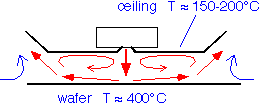Transport in APCVD Reactors: Simplified Analysis
Typical ceiling heights here are on the order of 1-2 cm. The gases exiting from the injector may induce recirculation near the ceiling, depending on the exact ceiling design; however, natural convection is normally suppressed by the very high flow velocities employed. We have corrected for the presence of recirculating regions by using an "effective" ceiling height. The ceiling is often constructed of a perforated stainless steel screen, through which an additional 10-15 slpm of nitrogen is dispensed to dilute the gases downstream and reduce powder formation; we have ignored that contribution here. The surface reaction rate constant is calculated to produce a peak rate of 500 nm/minute.

With these provisos, the transport analysis results are:

We see that the residence time is only about 5-10X longer than that in a typical low-pressure showerhead reactor despite the 100X increase in pressure. Velocities and diffusivites are greatly reduced at atmospheric pressure. The diffusion length is comparable to the ceiling height, so transport in the vertical direction is strongly influenced by diffusion (except in the immediate vicinity of the exit jet, where higher velocities are obtained). Transport along the stream is purely convective. Away from the jet region, these reactors somewhat resemble the simple plug flow example we studied earlier.
The Peclet number is huge with respect to the width: that is, the diffusion length is much smaller than the width of the injector, so diffusion doesn't have much effect. The injector must do a very good job of uniformity dispensing gases along its width to produce a laterally uniform deposit on the wafers, because diffusion in the chamber won't help. Finally, the Dahmkohler number is somewhat greater than 1 but not terribly large. Recall that this means that consumption of species at the surface is rather larger than the ability of species to diffuse there; the reactor is weakly transport-limited in the vertical direction, so substrate temperature will influence uniformity weakly and gas flow control is very important.
Return to Tutorial Table of Contents
Book version of the CVD Tutorial
